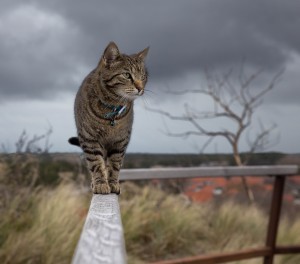 There are two popular schools of thought when it comes to our feline friends and where they reside: 1) domestic cats are relatives of wild cats and are happier and better off left outside, and 2) domestic cats are known as ‘house cats’ for a reason – they belong inside. Does keeping your favorite feline indoors go against nature? Would your kitty fare just as well outside as she does in? Are you a bad pet parent for not letting your cat go outside, despite her longing looks out the window and foiled attempts to sneak out of an open door?
There are two popular schools of thought when it comes to our feline friends and where they reside: 1) domestic cats are relatives of wild cats and are happier and better off left outside, and 2) domestic cats are known as ‘house cats’ for a reason – they belong inside. Does keeping your favorite feline indoors go against nature? Would your kitty fare just as well outside as she does in? Are you a bad pet parent for not letting your cat go outside, despite her longing looks out the window and foiled attempts to sneak out of an open door?
An outdoor life may be more fulfilling to your kitty’s wild side, but did you know it can shorten her life span to an average of only two to five years? Compared to the twenty-plus years a healthy indoor-only cat can survive, a mere two to five years just doesn’t seem fair.
The Risks of the Great Outdoors
It has been proven by researchers that the life of an outdoor cat is more stressful than that of an indoor cat, and stress can lead to physical and psychological disorders for a cat just as it can for a human. Your cat’s freedom to roam and hunt may benefit his natural instinct, but it can also lead to dangers, including:
- Exposure to infectious diseases such as the feline leukemia virus and feline immunodeficiency virus is greater in outdoor cats. Sure, vaccinations are helpful, but not infallible. Reducing your cat’s exposure to these diseases in a very important part of prevention.
- Outdoor cats are more likely to receive wounds from attacks or fights with other animals.
- They are also in danger of being struck by a moving vehicle.
- Outdoor cats can inadvertently ingest toxic chemicals, with self-grooming being hazardous after walking through a chemically treated yard.
- Infestation of fleas, ticks, mosquitos and any other insect looking to hitch a ride or find a food source is more common in outdoor cats.
- Some unsympathetic human may get angry over cat prints on his car or poop in his flower bed and retaliate in an unpleasant manner.
Your cat may be intelligent, agile and well-mannered, but it only takes one mistake to make outdoor life no life at all. One moment of fear-induced flight from a wild animal can result in your cat not noticing an oncoming car. One indulgence in a sweet treat of antifreeze can cause severe internal injury, or even death.
Fulfill Your Cat’s Primal Needs Indoors
Cats are sensory creatures who get pleasure from a variety of sights, tastes, smells and sounds. They need to exercise their bodies as well as their minds. Certainly the outdoors is the natural environment to fulfill your cat’s wants and needs, but you can easily satisfy her instincts and keep her safe by bringing the outdoors inside. Provide indoor grazing options by planting some cat nip or oat grass for your cat. Put a perch beside a window with a view. Provide a scratching post or kitty condo to keep your cat active and entertained. Better yet, welcome a second cat or a dog to the family to provide your kitty with additional companionship and entertainment.
The Bottom Line
Whether you choose to keep your cat inside or outside, it’s just that – your choice. But, before choosing, closely consider your environment and the possible hazards that abound and make the choice that is best and safest for your favorite feline.




